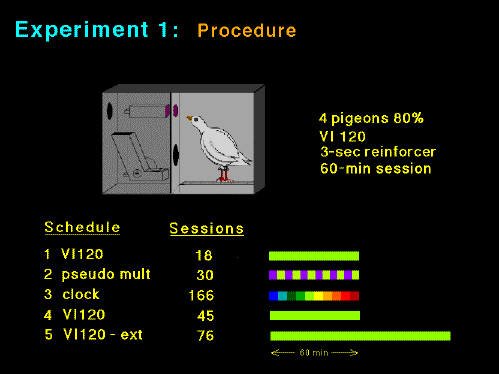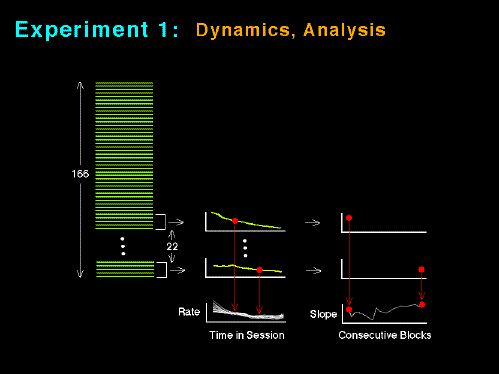 Figure 7
Figure 7


 Figure 6
Figure 6
The bitonic effect may vary as a function of explicit stimulus conditions. It is often relatively large in pseudo multiple schedules and smaller in simple schedules.
For example, McSweeny, Roll and Cannon found a strong effect while McSweeny & Johnson found a smaller effect.
Our first experiment explored the role of explicit stimulus conditions on the magnitude of rate change across the session.
We examined the stimulus factors using pigeons at 80% body weight under a VI 120-sec schedule with 3 sec reinforcers in 60-minute sessions.
The lower portion of the slide details the 5 phases of the experiment. The stimulus conditions in effect across the session are depicted to the right.
The first phase was in effect for 18 sessions.
The second phase was in effect for 30 sessions. In this phase the key light was simply alternated each 5 min.
The third phase was in effect for 166 sessions. The clock advanced every 6 min.
The fourth phase was in effect for 45 sessions.
The fifth phase was in effect for 76 sessions and was the same as the baseline, but had a 1 hour unsignaled extinction period following the session.
This slide details the data analysis. The mean rate in each 20-sec bin throughout the session, over the last 5 sessions was determined. The mean rate was normalized to 1. The session time was specified in hours. In addition, least squares straight lines were fit to the resulting 5 functions for each of the birds.
The results indicated only a modest, basically linear, decline across the session. The data indicated that the various explicit stimulus conditions did not differentially affect the change in rate across the session.
This slide details the particulars across birds and procedures.
 Figure 11
Figure 11
McSweeny has noted changes in the within-session rate change as a function of increasing experiance with the schedule. We maintained these birds under clock procedure for 166 sessions in order to examine the dynamics of the within-session rate change. This slide depicts the details of that analysis.
The final 110 sessions were grouped into 5-session blocks. The 5-day average was plotted. The consecutive changes of the slope of each of those 22 5-day averages were plotted.
Two birds exhibited stable within-session changes across the 22 blocks while 2 birds exhibited noticeable block-to-block variability. One bird showed an increase in the slope while the other bird showed a decrease in the slope.
This slide depicts the behavior of the bird showing the most variability. The upper frame shows the 22 5-session averages. The variation occurred at the session onset. The changes in the slope across the 22 blocks indicated that the change in slope was systematic even after more than 100 sessions.
So the take home message From Experiment 1: stimulus factors were not responsible for the magnitude of the within-session effect. Substantial long-term variability is possible.


Date Last Reviewed : January 6, 2002